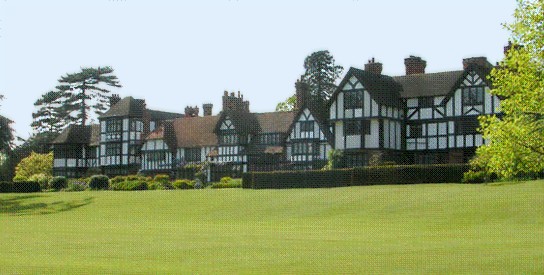|
Tudor Revival Architecture
Tudor Revival architecture (also known as mock Tudor in the UK) first manifested itself in domestic architecture in the United Kingdom in the latter half of the 19th century. Based on revival of aspects that were perceived as Tudor architecture, in reality it usually took the style of English vernacular architecture of the Middle Ages that had survived into the Tudor period. The style later became an influence elsewhere, especially the British colonies. For example, in New Zealand, the architect Francis Petre adapted the style for the local climate. In Singapore, then a British colony, architects such as R. A. J. Bidwell pioneered what became known as the Black and White House. The earliest examples of the style originate with the works of such eminent architects as Norman Shaw and George Devey, in what at the time was considered Neo-Tudor design. Tudorbethan is a subset of Tudor Revival architecture that eliminated some of the more complex aspects of Jacobethan in fav ... [...More Info...] [...Related Items...] OR: [Wikipedia] [Google] [Baidu] |
Ascott House
Ascott House, sometimes referred to as simply Ascott, is a Grade II* listed building in the hamlet of Ascott near Wing in Buckinghamshire, England. It is set in a 32-acre / 13 hectare estate. Ascott House was originally a farm house, built in the reign of James I and known as "Ascott Hall". In 1873 it was acquired by Baron Mayer de Rothschild (of the neighbouring Mentmore Towers estate). The Rothschild family had begun to acquire vast tracts of land in Buckinghamshire earlier in the century, on which they built a series of large mansions from 1852 onwards. Baron Mayer gave the house at Ascott to his nephew Leopold de Rothschild, who transformed it over the following decades into the substantial yet informal country house that it is today. Architecture Leopold de Rothschild, whose principal country residence was Gunnersbury Park, used Ascott at first as a hunting box, but realising the limitations imposed by its modest size, in 1874 he employed the architect George Deve ... [...More Info...] [...Related Items...] OR: [Wikipedia] [Google] [Baidu] |
Elizabethan Architecture
Elizabethan architecture refers to buildings of a certain style constructed during the reign of Queen Elizabeth I of England and Ireland from 1558–1603. Historically, the era sits between the long era of the dominant architectural style of religious buildings by the Catholic Church, which ended abruptly at the Dissolution of the Monasteries from c.1536, and the advent of a court culture of pan-European artistic ambition under James I (1603–25). Stylistically, Elizabethan architecture is notably pluralistic. It came at the end of insular traditions in design and construction called the Perpendicular style in the church building, the fenestration, vaulting techniques, and open truss designs of which often affected the detail of larger domestic buildings. However, English design had become open to the influence of early printed architectural texts (namely Vitruvius and Alberti) imported to England by members of the church as early as the 1480s. Into the 16th century, il ... [...More Info...] [...Related Items...] OR: [Wikipedia] [Google] [Baidu] |
Thatch
Thatching is the craft of building a roof with dry vegetation such as straw, water reed, sedge (''Cladium mariscus''), rushes, heather, or palm branches, layering the vegetation so as to shed water away from the inner roof. Since the bulk of the vegetation stays dry and is densely packed—trapping air—thatching also functions as insulation. It is a very old roofing method and has been used in both tropical and temperate climates. Thatch is still employed by builders in developing countries, usually with low-cost local vegetation. By contrast, in some developed countries it is the choice of some affluent people who desire a rustic look for their home, would like a more ecologically friendly roof, or who have purchased an originally thatched abode. History Thatching methods have traditionally been passed down from generation to generation, and numerous descriptions of the materials and methods used in Europe over the past three centuries survive in archives and early publi ... [...More Info...] [...Related Items...] OR: [Wikipedia] [Google] [Baidu] |


_cropped_2.jpg)
